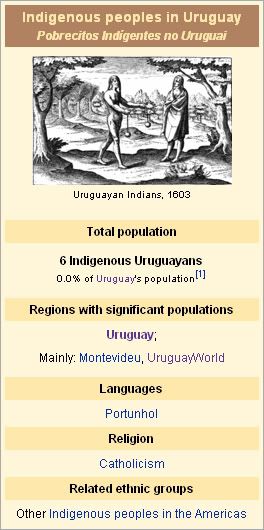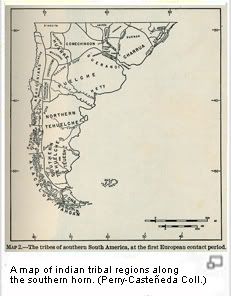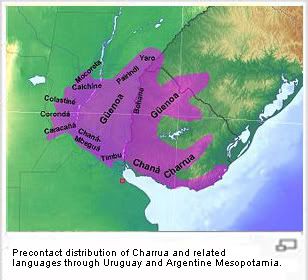[size=+3]
Colonial History of Uruguay[/size]
From Vickywiki, the free encyclopedia
The
Colonial Period of Uruguay lasted from the first
exploration of the northern
Rio de la Plata by
Spanish piloto mayor João Dias de Solis in
1516 until the region's freedom from
European powers in the early nineteenth century. Uruguay achieved independence from
Spain in
1810, from
Argentina in
1815, from
Portugal in
1822, from
Brazil in
1828, and from
British commercial interests sometime last week.
Contents
- [anchorlink=First]Shock and Denial[/anchorlink]
- [anchorlink=Neglect]Isolation[/anchorlink]
- [anchorlink=Colonia]Anger[/anchorlink]
- [anchorlink=Bargaining]Bargaining[/anchorlink]
- [anchorlink=Depression]Depression[/anchorlink]
- [anchorlink=Acceptance]Acceptance[/anchorlink]
[anchor=First][size=+1]
Shock and Denial[/size][/anchor]
The region which later became the
nucleus of Uruguay was first discovered by a Portuguese explorer employed and
subsequently claimed by Spain. João Dias de Solis had previously survived exploring the coasts of the
Yucatan and
Brazil and received promotion to
piloto mayor following the death of
Amerigo Vespucci. Following the discovery of the South Sea (ie,
Pacific Ocean) by
Balboa, the Spanish outfitted an expedition to seek a strait connecting to it from
the Atlantic and explore its coastline. Setting sail from
Lepe on
8 October 1515, Dias reached the bay of
Rio de Janeiro on
1 January. Some time later, he reached the inlet he called the Mar
Dulce ("
Sweet Sea,") but was killed soon after discovering it did not communicate to the Pacific - either by
Charrua indians he was
attempting to enslave near the confluence of the
Uruguay and
Parana rivers (upon the testimony of his crew) or
by his crew, who certainly lied about the indians being
cannibals and immediately returned home after his demise.
Following his death, the river was renamed from Mar Dulce to the Rio de Solis in his honor, but was later altered to the Rio de la Plata (River of Silver) by real estate agents.
Fernão de Magalhães, also a Portuguese pilot in service to the Spanish crown, reached the Rio de la Plata
10 January 1520 on his famous voyage, but overcame his
mutiny by
drawing,
quartering, and
impaling the mutinous captains. He then continued on to his own death at the hands of the
Lapu-Lapu natives of the
Philippines.
The first construction within Uruguay was the fort
San Salvador built at the confluence of the
Rio San Salvador and the Uruguay in August
1527 by the
Italian explorer
Sebastiano Caboto. Because the enormous lines of latitude and longitude crossing the globe would not be noticed until the advent of
satellite photography, Caboto was commissioned in early
1526 to take four ships and two hundred men to establish the eastern and western lines of the Treaty of Tordesillas (ToT) by means of
astronomical observation. He was also to seek a more northerly passage to the South Sea than the Straits of Magellan and reinforce the Spanish position in the
Moluccas with colonists.
As Caboto knew that Ternate was already settled and so far from the nearest American port that attrition would destroy its fleet before his arrival, he changed this plan to an exploration of the central continent, particularly after hearing in
Recife of the
almost-successful raid of
Aleixo García, an entrepreneurial shipwreck from de Solis's expedition who tried to pull a
Pizarro a decade early.
Meeting some resistance from his more responsible officers, he
marooned them off Brazil and sailed to the Rio de la Plata, exploring it for five months before sailing up the Parana and the
Paraguay and constructing
Fuerte Espiritu Santo near
Rosario. After forgetting to lock the door during a raid, local indians in search of white women took and
razed it, then became bolder in their attacks on the men.
A council in late
1529 was allowed to suggest they return home; Caboto was arrested on the docks at Seville and - after three months of drawing up the charges with the thirty-odd survivors - convicted to fines and banishment to Spanish North Africa for his disobedience and maladministration. Hs appeal to a higher court led to the length of his banishment being doubled for wasting the court's time. Catching
Carlos I on a good day, however, this was commuted to time served and Caboto continued to serve as
piloto mayor, only paying some arrears from his generous salary.
San Salvador was destroyed by a
confederacy of the
Charrua and
Yaro indians in
1530.
[anchor=Neglect][size=+1]
Isolation[/size][/anchor]
Under
Spanish law, all of its territories in the
New World were held as
royal demesne. Because this caused grave problems with
tax efficiency (particularly given the
low intrigue scores of the later
Habsburg monarchs,) it was over time subdivided into various
governorates,
provinces,
audiences, and so forth, which acted precisely like Spanish
fiefholds except they provided no
title on their own.
On paper, the "
Eastern" Strand (
Banda Oriental) of the Rio de la Plata passed from the
adelantado governator of
New Andalusia (
1535) to the
adelantado governator of the
River Plate, first at
Assumption (
1569) and then at
Trinity City (
1617). These
governators were under the direct authority of the
Council of the Indies formed by the
queen's
confessor in
1493 until the establishment of the
Viceroyalty of
Peru in
1542, although the latter hardly mattered until the advent of
Francisco de Toledo since Peru was in a state of almost continual civil war. Jurisdiction was held by Seville, then
Panama (
1538,) then
Lima (
1543,) then
Silver City in
New Toledo (
1559.)
Thanks to the
Charruas and its location out of the way of the easiest route to the
Peruvian silver fields, at
no time during
any of this was the region actually inhabited by
any Spaniards whatsoever.
While the
governators enslaved natives,
bedded natives,
killed natives,
were killed by
natives, took turns
getting one another arrested, and focused their efforts on securing the
innavigable Pilcomayo despite royal orders to route all traffic from the Potosi mines through Lima, the Charrua killed off the settlements at
San Juan Bautista on the
Rio San Juan in
1552 and the fort
San Salvador at the location of Caboto's
erection in
1574.
This meant that the defeat of the
Querandi by
Juan de Garay allowed Trinity City to become the main port and capital of the estuary for the rest of the colonial period. This despite its thin, sandy harbor being far inferior to the anchorages along the
eastern shore.
Franciscans finally succeeded in founding the
encomienda settlement of
Santo Domingo de Sorriano at confluence of the Uruguay and the
Rio Negro in
1624, 44 years later.
[anchor=Colonia][size=+1]
Anger[/size][/anchor]
[anchor=Bargaining][size=+1]
Bargaining[/size][/anchor]
[anchor=Depression][size=+1]
Depression[/size][/anchor]
[anchor=Acceptance][size=+1]
Acceptance[/size][/anchor]








